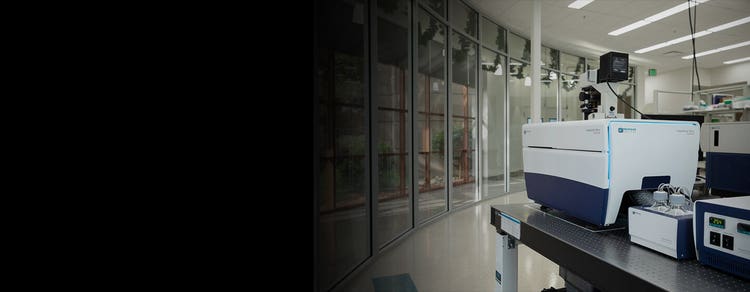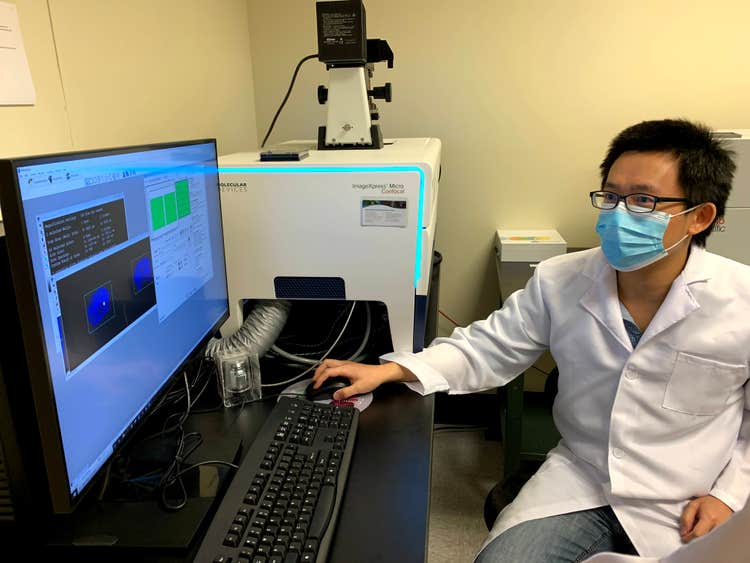

ImageXpress Micro Confocal High-Content Imaging System
Unique confocal imaging solution capable of imaging more than a million wells a week
High-content confocal imaging solution with water objective options
The ImageXpress® Micro Confocal system is a high-content solution that can switch between widefield and confocal imaging of fixed and live cells. It can capture high quality images of whole organisms, thick tissues, 2D and 3D models, and cellular or intracellular events. The spinning disk confocal and sCMOS camera enable imaging of fast and rare events like cardiac cell beating and stem cell differentiation. With MetaXpress software and flexible options like water immersion objectives to choose from, the system enables many confocal imaging applications from 3D assay development to screening.

Acquire higher quality images
Capture excellent contrast, high resolution images with our proprietary AgileOptix™ spinning disk confocal technology, wide field of view, and bright light source.

Customize image acquisition and analysis
Take ultimate control over acquisition and analysis parameters, which enables many applications from 3D structure analysis to target imaging of specific objects within an organism or cell populations. Run more applications with standard options like water immersion objectives, environmental control, or any of our high-performance customizations.

Analyze more data in less time
MetaXpress® PowerCore™ software accelerates analysis speed in a high-throughput environment. The software distributes image processing jobs to a multi-CPU environment.
Features

Wide dynamic range
Quantify low and high intensity signals in a single image with >3 log dynamic range intensity detection.

Exclusive AgileOptix spinning disk confocal
The technology provides increased sensitivity with specially designed optics, high-powered, solid state light engines, and sCMOS sensor. Swappable disc geometries provide flexibility between speed and resolution.

Wide field of view
Wide field of view enables whole-well confocal imaging and eliminates missed targets.

Optional on-board robotic fluidics
For assays that involve compound addition, well washing, and media exchange, optional on-board robotic fluidics are available.

Accurate 3D measurements
MetaXpress 3D analysis module is optimized for confocal imaging, enabling 3D measurements of volume and distance.

Multiple imaging modes
The system offers phase contrast and brightfield label-free imaging, fluorescence, widefield, colorimetric, and confocal imaging, as well as, water immersion imaging as a standard option.
AgileOptix™ technology
Our proprietary AgileOptix technology enables the ImageXpress Micro Confocal system to deliver the sensitivity and throughput needed for demanding applications. AgileOptix is the combination of a powerful solid state, light engine, specially designed optics, scientific CMOS sensor, and the ability to change disk geometries.

Cellular Image Gallery

Micro Confocal High-Content Imaging System

ImageXpress High-content imaging solution

ImageXpress Micro Confocal Imaging System

ImageXpress Micro Imaging System

Micro Confocal Imaging System
† Data and images were acquired during development using customer samples. Results may vary. Highlighted features’ price, time to deliver, and specifications will vary based on mutually agreed technical requirements. Solution requirements may cause adjustment to standard performance.
Latest Resources
Featured Applications
Customer Breakthrough

SUCCESS STORY
Visikol team develops 3D cell culture models to simulate the NASH and NAFLD disease progression process using ImageXpress Micro Confocal High-Content Imaging System and MetaXpress software
Expand your research using flexible, high-performance imaging solutions
Molecular Devices provides flexible options for the ImageXpress Micro Confocal High-Content Imaging System to meet your research needs and to easily capture images from different sample formats, including hanging drops and in round or flat bottom plates, for monitoring cell health kinetics under environmental control, and more. With over 30+ years of imaging expertise, we can help you select the right options to ensure the best images for your assay.
Standard hardware options

Water immersion objectives
20X, 40X, and 60X water immersion objectives improve the geometric accuracy during acquisition and reduce light refraction for brighter intensity at lower exposure times.

Transmitted light tower
Our transmitted light tower enables acquisition of high contrast images for unstained cells which can be easily viewed or separated from background.

Environmental Control
Environmental control maintains temperature and humidity levels while minimizing evaporation for multi-day, live cell, time-lapse imaging.

On-board robotic fluidics
Integrated fluidics automates assay workflows which require compound addition, well washing, and media exchange.
Customization options
Molecular Devices can successfully tailor the ImageXpress Micro Confocal High-Content Imaging System to include customized software and hardware including the features described below, as well as integration of other lab components such as incubators, liquid handlers, and robotics for a fully automated workcell. With over 30 years of experience in the life science industry, you can count on us to deliver quality products and provide worldwide support.
Sale is subject to our Custom Product Purchase Terms available at www.moleculardevices.com/custom-products-purchase-terms

High-Intensity lasers
Expand experiment capabilities with 5- or 7-channel high-intensity lasers.

Real-time dose response
Automatic pipettor enables compound addition while simultaneously live streaming at >100 frames per second.

Deep tissue penetrating confocal disk module
The deep tissue penetrating, confocal disk module reduces crosstalk to improve out-of-focus light suppression and penetrate deeper into tissue.

Turnkey, High-throughput long term kinetics
Schedule and image multiple plates over long periods of time while keeping consistent temperature, O2(Hypoxia), CO2, and humidity conditions. Expand live cell walk-away capacity to 200+ plates.

Scale up robotic automation
Increase throughput, eliminate human errors, maintain sterility, and achieve consistent sample handling. Modular automation design—components can be added in modules and are upgradeable.

High-intensity Lasers
High output laser excitation can reduce exposure times by up to 75%.† The laser light source is available as either a 5-channel or 7-channel light source with outputs of 400 —1,000 mW/channel. The 7-channel laser light source Includes near IR and is ideal for customers with increased multiplexing requirements.
- Obtain sharper images with higher signal-to-noise
- Generate up to a 2X† boost in scan speed attributed to significantly reduced exposure times
- Run FRET experiments using lasers for CFP and YFP



Deep Tissue Penetrating, Confocal Disk Module
Specialized deep tissue penetrating, confocal disk module, combined with a laser light source, improves light penetrance for deeper tissue penetration, resulting in sharper images with improved resolution when imaging thick tissue samples†.
- Improve suppression of out-of-focus light
- Reduce haze (pinhole crosstalk)
- Penetrate deeper into thick tissue samples for sharper images


†Data and images were acquired during development using customer samples. Results may vary. Highlighted features’ price, time to deliver, and specifications will vary based on mutually agreed technical requirements. Solution requirements may cause adjustment to standard performance.
Applications of ImageXpress Micro Confocal High-Content Imaging System
Specifications & Options of ImageXpress Micro Confocal High-Content Imaging System
Download Brochure

